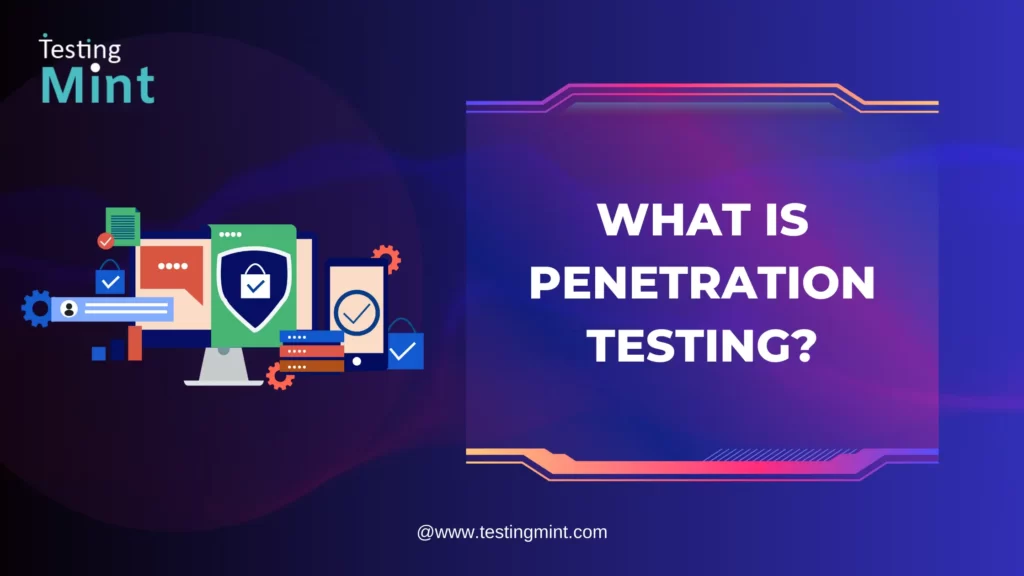In today’s world, where cyber attacks are becoming increasingly common and sophisticated, Penetration Testing is an essential security measure for any organization that handles sensitive information or valuable data. It helps organizations identify and mitigate security risks, protect their reputation, and maintain compliance with industry regulations.
What is Penetration Testing?
Penetration Testing, commonly known as pen-testing, is the process of testing a computer system, network, or web application for security vulnerabilities that a malicious hacker could exploit. The process involves simulating a real-world attack on the system or application to identify and exploit vulnerabilities, and then reporting them to the system owner for remediation.
Let’s take a real-world example to understand the importance of Penetration Testing. Suppose you own a house, and you have installed high-tech security systems like alarms, cameras, and locks to protect it. But you never tested the security systems to see if they actually work. One day, a burglar enters your house, and you realize that the security systems were not enough to protect your house. Similarly, without Penetration Testing, you may not know if your computer system or network is vulnerable to cyber attacks.
Types of Penetration Testing
Penetration Testing can be categorized into three types based on the level of information given to the tester. These types are:
1. Black Box Testing
In Black Box Testing, the tester has no prior knowledge of the system or application being tested. It simulates an attack from an external hacker who has no internal knowledge of the system. The tester tries to gain access to the system by exploiting vulnerabilities in the same way that a real hacker would.
For example, imagine a thief who is trying to break into a house without any prior knowledge of the house’s layout or security systems. The thief will try to find the weak points of the house and exploit them to gain access.
2. White Box Testing
In White Box Testing, the tester has complete knowledge of the system or application being tested. The tester has access to the source code, architecture diagrams, and other technical details. This type of testing is useful in identifying vulnerabilities that are difficult to discover using other methods.
For example, imagine a locksmith who has been hired to test the security of a house. The locksmith has access to the layout of the house, the type of locks used, and other technical details that can help them identify weaknesses in the security system.
3. Gray Box Testing
In Gray Box Testing, the tester has limited knowledge of the system or application being tested. The tester has partial knowledge of the system, such as user access or network architecture. This type of testing is useful in identifying vulnerabilities that require some internal knowledge of the system but do not require full access.
For example, imagine a neighbor who knows the basic layout of a house but doesn’t have access to the security codes or technical details. The neighbor may be able to identify potential weaknesses in the security system by observing the house from the outside.
Penetration Testing Methodology
Penetration Testing involves a well-defined methodology to ensure comprehensive coverage of the system being tested. The methodology consists of the following steps:
1. Planning and Preparation
The first step in Penetration Testing is to define the scope of the test, identify the assets to be tested, and obtain necessary permissions. The tester also needs to understand the business objectives and constraints to ensure that the test does not impact the system’s performance or availability.
2. Reconnaissance
In this step, the tester gathers information about the system or application being tested. This includes identifying the network architecture, software platforms, and potential vulnerabilities.
3. Scanning and Enumeration
The tester uses automated tools to scan the network or application for vulnerabilities. This includes identifying open ports, running services, and potential weaknesses in the system.
4. Exploitation
In this step, the tester attempts to exploit the identified vulnerabilities to gain access to the system or application. The tester may use tools like Metasploit or other frameworks to launch attacks and gain access.
5. Post-Exploitation
Once the tester has gained access to the system, they will try to maintain access and escalate privileges. This includes identifying other systems on the network, stealing sensitive data, and installing backdoors.
6. Reporting
The final step in Penetration Testing is to document the findings and provide recommendations for remediation. The report should provide a detailed analysis of the vulnerabilities and potential impact, along with remediation recommendations.
Common Vulnerabilities Targeted in Penetration Testing
The following are the most common vulnerabilities targeted in Penetration Testing:
1. Authentication and Authorization
Authentication and Authorization vulnerabilities are among the most common vulnerabilities targeted in Penetration Testing. These vulnerabilities include weak passwords, easily guessable usernames, and insufficient access controls. Attackers can exploit these vulnerabilities to gain unauthorized access to the system.
2. Network and System Configuration
Network and System Configuration vulnerabilities are another common target of Penetration Testing. These vulnerabilities include misconfigured firewalls, open ports, and default settings that can be exploited by attackers to gain access to the system.
3. Encryption and Cryptography
Encryption and Cryptography vulnerabilities are also a common target of Penetration Testing. These vulnerabilities include weak encryption algorithms, insufficient key lengths, and implementation errors that can be exploited by attackers to bypass encryption and gain access to sensitive information.
4. Application-level Vulnerabilities
Application-level vulnerabilities are also targeted in Penetration Testing. These vulnerabilities include input validation errors, buffer overflows, and injection flaws that can be exploited by attackers to compromise the application and gain unauthorized access to the system.
Penetration Testing Tools
Penetration Testing involves the use of various tools and techniques to identify and exploit vulnerabilities in the system being tested. These tools can be categorized into the following types:
1. Network Scanners
Network Scanners are used to identify open ports, running services, and potential vulnerabilities in the network. Some popular network scanners include Nmap, Nessus, and OpenVAS.
2. Exploitation Frameworks
Exploitation Frameworks are used to launch attacks on the system being tested. These frameworks include Metasploit, Core Impact, and Canvas.
3. Password Crackers
Password Crackers are used to crack passwords and gain access to the system. These tools include John the Ripper, Cain and Abel, and Hydra.
4. Traffic Analyzers
Traffic Analyzers are used to capture and analyze network traffic. These tools include Wireshark, tcpdump, and Snort.
5. Web Application Scanners
Web Application Scanners are used to identify vulnerabilities in web applications. These tools include Burp Suite, Acunetix, and OWASP ZAP.
6. Wireless Scanners
Wireless Scanners are used to identify vulnerabilities in wireless networks. These tools include Aircrack-ng, Reaver, and Kismet.
Benefits of Penetration Testing
Penetration Testing provides several benefits to organizations. The following are the most significant benefits of Penetration Testing:
1. Identifying Security Weaknesses
Penetration Testing helps organizations identify security weaknesses in their systems. By simulating real-world attacks, Penetration Testing can identify vulnerabilities that may not be apparent through other security testing methods. This allows organizations to remediate identified vulnerabilities and improve the overall security of their system.
2. Mitigating Security Risks
Penetration Testing helps organizations mitigate security risks by identifying and remedying vulnerabilities in their system. By addressing vulnerabilities before they are exploited by attackers, organizations can reduce the risk of a successful attack and minimize the potential impact of an attack.
3. Meeting Compliance Requirements
Penetration Testing is often required by regulatory bodies and industry standards to ensure that organizations comply with security requirements. By conducting Penetration Testing, organizations can demonstrate their commitment to security and compliance.
Limitations of Penetration Testing
While Penetration Testing provides several benefits, it also has some limitations. The following are the most significant limitations of Penetration Testing:
1. Time Constraints
Penetration Testing can be a time-consuming process, especially for large or complex systems. The testing process requires significant planning, preparation, and execution, which can take several weeks or even months to complete. This can be a challenge for organizations with tight timelines or limited resources.
2. Limited Scope
Penetration Testing has a limited scope and can only identify vulnerabilities that are present at the time of testing. As such, it may not identify vulnerabilities that emerge after the testing is complete or that are not part of the testing scope. This means that organizations must continue to monitor their system and address emerging vulnerabilities.
3. False Sense of Security
Penetration Testing can provide a false sense of security if not conducted properly. Some organizations may believe that their system is secure after conducting Penetration Testing, even though vulnerabilities may still exist. This can lead to complacency and a lack of ongoing security monitoring and remediation efforts.
Conclusion
In conclusion, Penetration Testing is a valuable tool that can help organizations improve their security posture. By understanding its benefits and limitations, organizations can make informed decisions about conducting Penetration Testing and take steps to ensure the ongoing security of their systems.
If you are an organization that has not yet conducted Penetration Testing, we encourage you to consider doing so. Penetration Testing can help you identify security weaknesses and mitigate security risks, thereby improving the overall security of your system. Remember to work with a reputable Penetration Testing provider and to conduct ongoing security monitoring and remediation efforts to ensure the continued security of your system.

